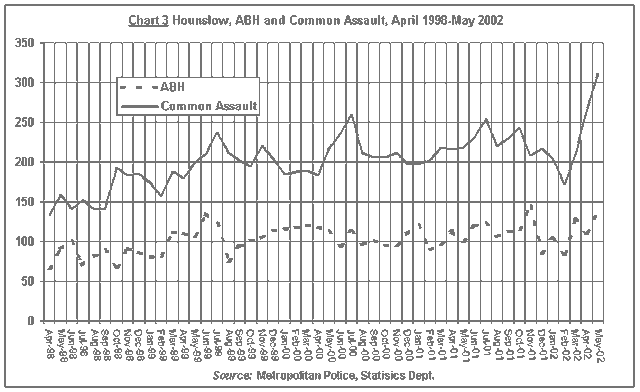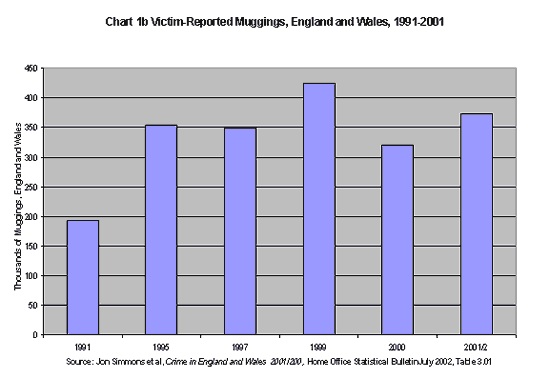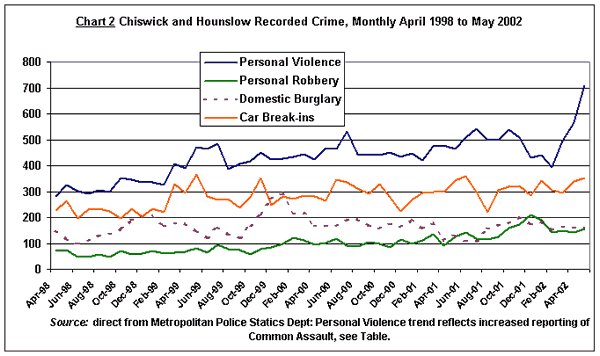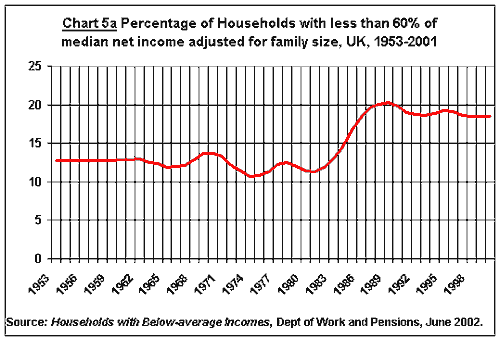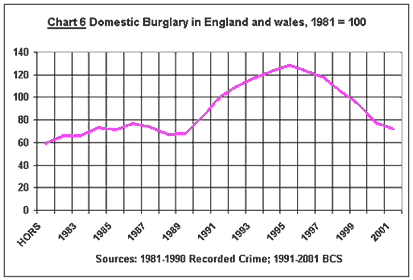Robin Marris on local crime
Related links
|
LONG AND SHORT-TERM CRIME TRENDS IN ENGLAND AND WALES, HOUNSLOW AND CHISWICK By Robin Marris Robin Marris is a retired economics Professor of London University who live in Chiswick and currently works for the Home Office in the study of crime trends Background to the Facts For reasons which are not understood, crime figures jump about. If you read that a certain type of crime in a certain area is 'up 5%', the simple reason may be that in the previous year the figure fell by 5%, so over the two years the actual trend was flat. There are three kinds of crime statistics: Reported Crime, Recorded Crime and Victim-Reported Crime.
The Police have discretion as to whether to decide that a reported crime should be recorded. Eg a publican calls the police because there is a brawl. They arrive and find a number of young men with black eyes, bloody noses and slashed cheeks. But all refuse to press charges. What should be recorded? In the past the answer has varied from crime to crime, police force to police force and from time to time. Government has now imposed standardisation, with two effects - a greater proportion of reported crimes will be recorded and the changeover is being made by different police forces at different times. This makes recent recorded crime figures difficult to interpret. It is my impression that at least in respect of some crimes, the Hounslow and Chiswick police district made the changeover between February and April this year (2002). This would explain the otherwise unexplained near-doubling of cases of Common Assault recorded by police in the Borough between those two months. (See Chart 3 below).
The BCS (ie Victim-Reported) data are much more reliable because they don't suffer the above-described problem and also include some, but not all actual crimes which for one reason or another have not been reported to the police. Unfortunately, the BCS report is necessarily about nine months in arrears. The recent publication in July gave annual figures relating to the period corresponding to the financial year 2001/2, i.e. figures that indicate the general situation around November last. By contrast, Scotland Yard has kindly provided me with our police district's detailed Recorded crime data on a month-to-month basis up to last April. So lets start by looking at some BCS national figures and then, with caution, at the more recent Recorded figures. (See Chart 1.)
Burglary from homes reached a peak in 1995 and has since been falling steadily. Theft from Cars has behaved erratically. It exploded in 1999, has since fallen back but is still running a little higher than in 1991. Violence where the attacker is not known to the victim and where robbery is not the apparent motive (i.e., typically fighting among young men, legally classified as Common Assault) doesn't seem to show any significant trend. By contrast, Common Assault as such, having also reached a peak in mid nineties, is, in these figures, falling sharply. As will be seen, this victim-reported national story is strongly different from the police-recorded local story. Street Mugging (bag-snatching and taking property by violence or threat of violence), because the total numbers are smaller than for the other crimes, is best studied on a larger-scale chart. See Chart 1b below.
At the beginning of the decade 1990-2000 the chance of being mugged in any given year for the average member of the adult population was around one in two hundred. By the end of the decade that risk had doubled (i.e. became one in a hundred). Between 1999 and 2000 the figure fell back sharply to a level halfway from where it had begun and then, unfortunately, in the next year, i.e. 2001/2002, rose again by enough to put as back to a situation where mugging is two thirds worse, nationally than it was in 1990. I think the Government is therefore absolutely right in giving high priority to this problem. My guess is that as a result we shall a see a major decline in 2002/3, with uncertainty thereafter.
The category 'Personal Violence' mainly includes the legal offences of Grievous Bodily Harm, Actual Bodily Harm and Common Assault. It will include some but not all muggings. It appears to have increased substantially during 1998, then flattened and then, in March 1992, exploded. Chart 3 shows that this was entirely due to Common Assault and for the reasons already given is almost certainly due to changed police recording conventions, rather than any actual increase in actual violence. More gradual change of practice may also be responsible for the movements of the earlier figures. Car crime also increased in 1998, but, although showing ups and downs, has basically since remained steady. Burglary of Homes. The national long trend is downward, but I personally cannot see any trend, either way, in the recent local figures. 'Personal Robbery' roughly corresponds to BCS Mugging and it is my impression that the local figures are consistent with the national story already described. Crime in Chiswick The Hounslow Chiswick Area Committee recently received a report on Crime Statistics in Chiswick, which gives ward-by-ward figures of Notified Crime Apr-Sept and Oct-Mar, 2001/2002. Notified Crime corresponds to Reported, rather than Recorded, crime and it is to be presumed that for both periods they follow the new recording practices. The problem is that the figures for individual wards are sufficiently small by mathematical standards that they must be subject to substantial statistical random error. For example total burglaries increased in Homefields Ward by 10 on 76. This could be the work of a particular gang or it could be a statistical blip. I have calculated however, that taking a longer view the burglary rate, per household, in Homefields Ward is high by both national and local standards. It is my general opinion that underlying trends in various crimes in Chiswick are consistent with the picture of a typical national middle-crime community. The Causes of Crime My work for the Home Office has given me a rather wide knowledge of all kinds of research that has been done on the social and economic causes of crime both in the UK and in the US. This is my view of the general picture: The great proportion of all crime is committed by males between the ages of 10 and 35, with a heavy concentration in the band 18-25. In effect, most crime is committed by a revolving gang of about 100,000 males. While new entrants come of age, a certain proportion of existing members, every year, go straight. These active criminals commit between 10 and 20 crimes each per year. Although the police clear-up prospect for any one crime is low, the probability that in any one two-year period an active criminal will be caught and convicted for some of his crimes is high. The average prison sentence is also about two years, so the gang is also revolving through the criminal justice system and the prisons, re-offending and, eventually 'desisting'. The first time a person is convicted they go into a national data base called the Offender's Index. Each time they are subsequently convicted the fact is added to their record. If a person previously showing up regularly permanently disappears from the record it is more likely that they have actually gone straight than that they have discovered a way of never getting caught. The new supply of active criminals comes from the new supply of young men who are susceptible, i.e. probably less than one in ten of each age cohort. The highest risk factor for criminal susceptibility is a home which is relatively poor - in the sense of a household net income, adjusted for family size, less than 60% of the national median - average where there are three or more children and where the natural father has been substituted by another male (either stepfather or partner). Poor lone mothers with small families often do well, but if they have three or more children especially boys they have difficulty in preventing at least one of them from going astray. Finally, a major risk factor for a boy in a poor family is below-average academic talent. He will bunk off from school, meet active criminals, and may well then become one himself. Fortunately, there is also an outflow from the active criminals, i.e. the 'desisters'. The total number of active criminals therefore fluctuates through time with changes in the balance of inflow and outflow. The criminality (average numbers of crimes per year) of active criminals depends on: 1.
The value of goods available to be stolen (e.g.
cars, their contents, domestic consumer goods
etc), which rises over time as society becomes
richer (growth of GDP) The long term picture The consequences of the above are that as we get more prosperous we shall experience more property crime (but not necessarily more violent crime, which latter, by the way has been found to change from year to year rather closely with annual beer consumption!), unless (1)
Police numbers rise as fast as GDP, which means,
in practice, faster than the population. In the half century that has just passed neither of these things happened. Consequently the crime rate per head of population rose steadily. Then in the middle nineteen-eighties, condition (2) went sharply in the wrong direction. Between 1985 the proportion of households below 60% of the median net income rose from 10% to 20%. (See Chart 5a)
The proportion of boys aged 15 raised in a lone-mother family which was also poor went from 20% in 1980 to 45% in 1990 and fortunately fell back to 35% in 2000. We don't have historical statistics on stepfathers but I have estimated (See Chart 5b) that there must in fact have been a corresponding jump in the supply of potential criminals.
The Result in terms of Burglaries Chart 6 is a statistical series which 'splices' the police-recorded data before 1990 with the BCS data thereafter. I think that is a reasonably accurate procedure because there is indirect evidence of police under-recording of burglaries in the period 1990-1995 as they were, in effect, partly overwhelmed by the crime wave.
If you look at Chart 6 with Charts 5a and 5b it is fairly obvious what happened. After a short lag, the increase in poverty generated more criminals who committed more crimes. The police were partly overwhelmed, thus making the situation worse. Since police numbers have not increased and relative poverty has not fallen, did the burglary rate fall back. I am not sure of the answer but I think the reasons are probably: (1)
Increased security The Prisons When crime jumps, unless there is also an immediate increase in police, the arrest rate falls, but, nevertheless, there are more arrests and more imprisonments. Responding to public concern, judges imprison an increasing proportion of convictees (as against probation etc). The jails fill up and go on doing so until sometime after the crime wave has reversed. This is what is happening in the UK today. The same thing happened in the US ten years earlier. As a result the US, comparatively speaking has an enormous prison population. Taking a white male aged 25 years, such a person, in the US has four times the chance of being now in prison than the corresponding person in the UK, and the UK person, in turn, has twice the chance of being in prison than is the case in the typical European country. Crime and Ethnicity It must frankly be accepted that young men of colour whose ancestors were transported from Africa 250 years ago, then spent five generations in slavery and then another five in near-slavery, and whose families have since come to the UK, are over-represented in all crime and prison statistics. My belief that one of the causes is a long hangover of the disrupting effect of slavery and near-slavery on family life and the male role is somewhat supporting by some data suggesting that people who have come to this country directly from West Africa do better. The effect on total crime must not be overestimated. I calculate that if West Indian males had average, rather than elevated, crime rates, the national crime rate would be reduced by about five per sent. But in some locations (of which Hounslow is not one), of course, the effect would be considerably stronger.
August 27, 2002
Soham Copycat Feared on King Street Latest figures show crime in Chiswick falling Crime in Chiswick - ward by ward Get notified of local crime through Ringmaster How safe are the underpasses under the A4?
|
